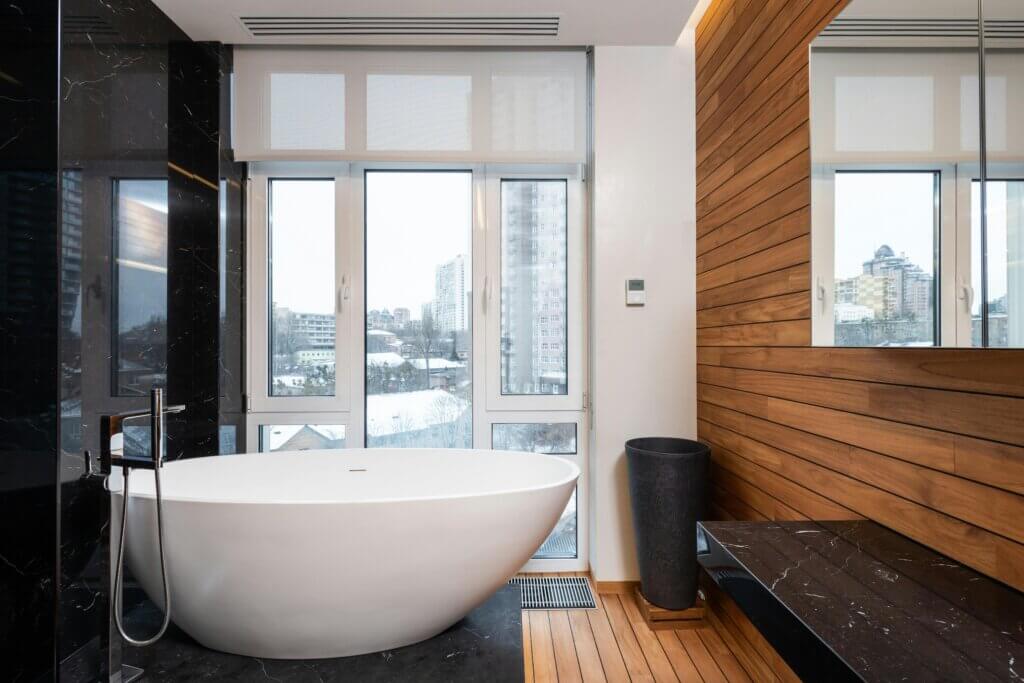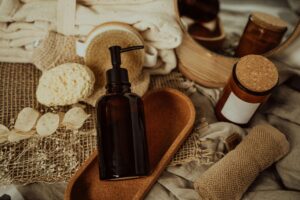Disclaimer: This post contains affiliate links, including links to Amazon. As an Amazon Associate, we earn from qualifying purchases at no additional cost to you. Thank you for supporting Low Tox & Thrive!
When we think about creating a healthy, low tox home environment, it can be easy to overlook the bathroom. The reality is, however, that it’s a space where toxins—and a lot of them—can accumulate, affecting our well-being and indoor air quality.
According to the Environmental Protection Agency (EPA), indoor air can be 2 to 5 times more polluted than outdoor air, with certain areas, like bathrooms, often harboring higher levels of volatile organic compounds (VOCs) from cleaning products and personal care items.
Creating a low tox bathroom can help reduce your exposure to harmful chemicals while promoting a cleaner, safer environment for you and your family. This guide will walk you through how to do it.
Understanding toxins in the bathroom
Bathrooms often contain numerous personal care products, cleaning supplies, and other items that may contain harmful substances. For instance, one study found that half of US cosmetics contain toxic chemicals.
It’s not just cosmetics either. Many conventional products are laden with chemicals like parabens, phthalates, and synthetic fragrances, which can disrupt hormonal balance and lead to other health issues. By reducing or eliminating these toxins, you can create a healthier space that supports your overall well-being.
Step-by-step guide to create a low tox bathroom
1. Declutter and simplify
Start by going through all the items in your bathroom. Discard any products that contain harsh chemicals or that you rarely use. This not only helps you create a more organized space but also allows you to focus on using safer alternatives.
2. Choose natural personal care products
Look for personal care items such as shampoos, conditioners, body washes, and skincare products made from natural ingredients like coconut oil, shea butter, and essential oils. Look for brands that focus on using plant-based ingredients and avoid harmful additives, and labels that emphasize “organic” or “non-toxic.”
Or, make your own personal care products
Creating your own personal care products is an easy way to reduce your exposure to toxic ingredients. Try this coffee body scrub, for example. These homemade products can be just as effective—if not more so—as their commercial counterparts, often at a fraction of the cost.
Check out our guide to natural skincare for more ideas.
3. Use natural cleaning supplies
In addition to your personal care products, you’ll want to evaluate the cleaning products you use. Many common bathroom cleaners and disinfectants are filled with chemicals like bleach, ammonia, and synthetic fragrances that can irritate your skin, eyes, and respiratory system. And long-term exposure can lead to even more serious health issues.
Instead, opt for plant-based or non-toxic cleaning products. These cleaners use natural ingredients like vinegar, baking soda, and essential oils to break down grime and disinfect without leaving harmful residues behind.
Read product labels carefully
When purchasing store-bought non-toxic cleaners, be sure to check the labels. Certifications like EcoLogo, Green Seal, and Safer Choice are good indicators that the products meet environmental and safety standards. Avoid products that list “fragrance” as an ingredient, as these often contain harmful chemicals hidden under the term.
These natural cleaners from Seventh Generation, PathoPure, and Aunt Fannie’s are all highly-rated and effective.
Better yet, make your own cleaning products
Not only are DIY options effective, but because you know exactly what’s in it, they’re also much safer for your health and the environment. Here are some simple DIY cleaning recipes you can try:
- All-purpose cleaner: Mix equal parts water and vinegar, add a few drops of tea tree or lemon essential oil for a fresh scent and added cleaning power. Use it to wipe down sinks, counters, and mirrors.
- Toilet bowl cleaner: Sprinkle baking soda around the inside of the toilet, then spray with vinegar (it’ll fizz up). Let it sit for a few minutes before scrubbing with a toilet brush.
- Tile and grout cleaner: Mix baking soda with water to form a paste, apply to grout lines, and scrub with a brush. Rinse with warm water.
4. Ditch artificial air fresheners
Many people use air fresheners, scented candles, or plug-ins to mask odors in the bathroom. Unfortunately, these products often contain synthetic fragrances and chemicals like phthalates that can contribute to poor indoor air quality.
Try these natural alternatives
- DIY air freshener spray: Mix water with a few drops of your favorite essential oils in a spray bottle for a quick, easy air freshener.
- Essential oil diffusers: Add a few drops of essential oil like lavender, eucalyptus, or lemon to a diffuser for a refreshing scent.
- Indoor plants: Certain houseplants, like spider plants and peace lilies, can effectively remove indoor air pollutants. Just be sure to choose plants that thrive in the humidity of a bathroom.
Synthetic fragrances are often found in air fresheners, candles, and personal care products. They can contain phthalates and other harmful chemicals that contribute to indoor air pollution. Research from the FDA indicates that many people are sensitive to these fragrances, which can trigger skin irritation and respiratory issues.
Instead, opt for products scented with natural essential oils or use natural alternatives like beeswax candles to freshen up your bathroom.
5. Invest in low tox materials
One often-overlooked area when creating a low tox bathroom is the textiles we use, like towels, bath mats, and shower curtains. Many textiles are treated with chemicals such as formaldehyde or flame retardants, which can be harmful when inhaled or absorbed through the skin.
Easy swaps for low tox bathroom textiles
- Towels: Replace synthetic towels with ones made from organic cotton, bamboo, or linen. These materials are naturally hypoallergenic, free from harmful chemicals, and feel much softer on the skin.
- Shower curtains: PVC (vinyl) shower curtains are known to off-gas harmful chemicals like phthalates into the air. Instead, opt for a shower curtain made from PEVA or natural fabrics like linen or hemp.
- Bath mats: Choose natural fiber bath mats, such as those made from organic cotton or jute, to avoid synthetic materials treated with chemicals. These mats are often more absorbent and durable too.
Planning a bathroom reno?
If you’re planning a bathroom renovation or update, consider using non-toxic materials and fixtures. Look for paints, adhesives, and flooring options that are labeled as low VOC, which can significantly improve indoor air quality according to the EPA.
6. Install a water filtration system
The water in your bathroom may contain contaminants like chlorine, heavy metals, and fluoride, which can irritate your skin and hair. Installing a water filter on your shower head or sink faucet is an effective way to reduce your exposure to these toxins.
Filtered water is gentler on your skin and hair, especially if you have sensitive skin or conditions like eczema. There are plenty of affordable shower head filters available that can be installed in minutes and help remove chlorine and other impurities.
7. Ensure proper ventilation
Good ventilation is key to reducing humidity and preventing mold growth in your bathroom. Mold can trigger asthma and allergic reactions. Make sure your bathroom has an exhaust fan or a window that you can open to allow fresh air to circulate. This will help dissipate any lingering chemical odors and improve air quality.
Make your bathroom a sanctuary, not a source of stress
Creating a low tox bathroom is a powerful way to support both your health and the environment. By choosing safer products and incorporating natural alternatives, you can reduce your exposure to toxins and transform your bathroom into an oasis that supports your well-being.







